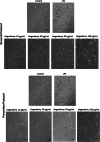Glioprotective Effects of Lingonberry Extract Against Altered Cellular Viability, Acetylcholinesterase Activity, and Oxidative Stress in Lipopolysaccharide-Treated Astrocytes
- PMID: 29556871
- PMCID: PMC11481962
- DOI: 10.1007/s10571-018-0581-x
Glioprotective Effects of Lingonberry Extract Against Altered Cellular Viability, Acetylcholinesterase Activity, and Oxidative Stress in Lipopolysaccharide-Treated Astrocytes
Abstract
Altered astrocytic function is a contributing factor to the development of neurological diseases and neurodegeneration. Berry fruits exert neuroprotective effects by modulating pathways involved in inflammation, neurotransmission, and oxidative stress. The aim of this study was to examine the effects of the lingonberry extract on cellular viability and oxidative stress in astrocytes exposed to lipopolysaccharide (LPS). In the reversal protocol, primary astrocytic cultures were first exposed to 1 µg/mL LPS for 3 h and subsequently treated with lingonberry extract (10, 30, 50, and 100 μg/mL) for 24 and 48 h. In the prevention protocol, exposure to the lingonberry extract was performed before treatment with LPS. In both reversal and prevention protocols, the lingonberry extracts, from 10 to 100 μg/mL, attenuated LPS-induced increase in reactive oxygen species (around 55 and 45%, respectively, P < 0.01), nitrite levels (around 50 and 45%, respectively, P < 0.05), and acetylcholinesterase activity (around 45 and 60%, respectively, P < 0.05) in astrocytic cultures at 24 and 48 h. Also, in both reversal and prevention protocols, the lingonberry extract also prevented and reversed the LPS-induced decreased cellular viability (around 45 and 90%, respectively, P < 0.05), thiol content (around 55 and 70%, respectively, P < 0.05), and superoxide dismutase activity (around 50 and 145%, respectively, P < 0.05), in astrocytes at both 24 and 48 h. Our findings suggested that the lingonberry extract exerted a glioprotective effect through an anti-oxidative mechanism against LPS-induced astrocytic damage.
Keywords: Acetylcholinesterase; Astrocyte; Cellular viability; Lingonberry extract; Lipopolysaccharide; Oxidative stress.
Conflict of interest statement
The authors declare that they have no conflict of interest.
Figures







Similar articles
-
Effect of Thiazolidin-4-one Against Lipopolysaccharide-Induced Oxidative Damage, and Alterations in Adenine Nucleotide Hydrolysis and Acetylcholinesterase Activity in Cultured Astrocytes.Cell Mol Neurobiol. 2023 Jan;43(1):283-297. doi: 10.1007/s10571-021-01177-1. Epub 2022 Jan 15. Cell Mol Neurobiol. 2023. PMID: 35031909 Free PMC article.
-
Glioprotective Effect of Chitosan-Coated Rosmarinic Acid Nanoemulsions Against Lipopolysaccharide-Induced Inflammation and Oxidative Stress in Rat Astrocyte Primary Cultures.Cell Mol Neurobiol. 2020 Jan;40(1):123-139. doi: 10.1007/s10571-019-00727-y. Epub 2019 Aug 24. Cell Mol Neurobiol. 2020. PMID: 31446560 Free PMC article.
-
Acetate Attenuates Lipopolysaccharide-Induced Nitric Oxide Production Through an Anti-Oxidative Mechanism in Cultured Primary Rat Astrocytes.Neurochem Res. 2016 Nov;41(11):3138-3146. doi: 10.1007/s11064-016-2038-2. Epub 2016 Aug 20. Neurochem Res. 2016. PMID: 27542961
-
[Effects of lingonberry extraction on the mice cognitive function damaged by chronic stress].Wei Sheng Yan Jiu. 2015 Nov;44(6):943-8. Wei Sheng Yan Jiu. 2015. PMID: 26738388 Chinese.
-
Lingonberry (Vaccinium vitis-idaea L.) Fruit as a Source of Bioactive Compounds with Health-Promoting Effects-A Review.Int J Mol Sci. 2021 May 12;22(10):5126. doi: 10.3390/ijms22105126. Int J Mol Sci. 2021. PMID: 34066191 Free PMC article. Review.
Cited by
-
Bu Shen Yi Sui Capsule Promotes Myelin Repair by Modulating the Transformation of A1/A2 Reactive Astrocytes In Vivo and In Vitro.Oxid Med Cell Longev. 2022 Sep 1;2022:3800004. doi: 10.1155/2022/3800004. eCollection 2022. Oxid Med Cell Longev. 2022. PMID: 36092158 Free PMC article.
-
Effect of Thiazolidin-4-one Against Lipopolysaccharide-Induced Oxidative Damage, and Alterations in Adenine Nucleotide Hydrolysis and Acetylcholinesterase Activity in Cultured Astrocytes.Cell Mol Neurobiol. 2023 Jan;43(1):283-297. doi: 10.1007/s10571-021-01177-1. Epub 2022 Jan 15. Cell Mol Neurobiol. 2023. PMID: 35031909 Free PMC article.
-
A mechanistic study on the inhibition of bacterial growth and inflammation by Nerium oleander extract with comprehensive in vivo safety profile.BMC Complement Med Ther. 2021 May 1;21(1):135. doi: 10.1186/s12906-021-03308-z. BMC Complement Med Ther. 2021. PMID: 33933037 Free PMC article.
-
Interaction of Polyphenols as Antioxidant and Anti-Inflammatory Compounds in Brain-Liver-Gut Axis.Antioxidants (Basel). 2020 Jul 26;9(8):669. doi: 10.3390/antiox9080669. Antioxidants (Basel). 2020. PMID: 32722619 Free PMC article. Review.
-
Mesenchymal stem cell-derived exosomes as a nanotherapeutic agent for amelioration of inflammation-induced astrocyte alterations in mice.Theranostics. 2019 Aug 14;9(20):5956-5975. doi: 10.7150/thno.33872. eCollection 2019. Theranostics. 2019. PMID: 31534531 Free PMC article.
References
-
- Acosta C, Anderson HD, Anderson CM (2017) Astrocyte dysfunction in Alzheimer disease. J Neurosci Res. 10.1002/jnr.24075 - PubMed
-
- Aebi H (1984) Catalase in vitro. Methods Enzymol 105:121–126. 10.1016/S0076-6879(84)05016-3 - PubMed
-
- Aksenov MY, Markesbery WR (2001) Changes in thiol content and expression of glutathione redox system genes in the hippocampus and cerebellum in Alzheimer’s disease. Neurosci Lett 302(2–3):141–145. 10.1016/S0304-3940(01)01636-6 - PubMed
-
- Ali SF, LeBel CP, Bondy SC (1992) Reactive oxygen species formation as a biomarker of methylmercury and trimethyltin neurotoxicity. Neurotoxicology 13(3):637–648 - PubMed
MeSH terms
Substances
Grants and funding
LinkOut - more resources
Full Text Sources
Other Literature Sources

